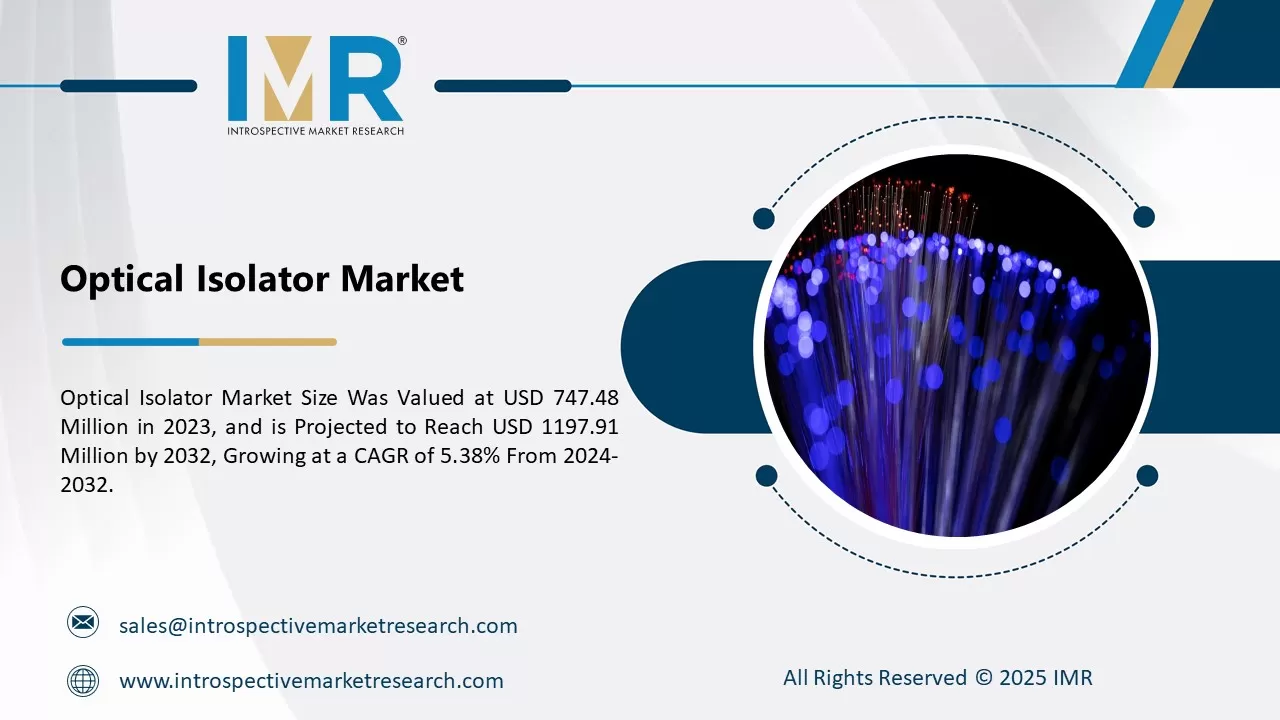Market Overview:
According to a new report published by Introspective Market Research, titled, ?Fiber Optic Collimating Lens Market by Type, Lens Type, Mode, Application Global Market Analysis and Forecast, 2024-2032. The global Fiber Optic Collimating Lens Market size was valued at $ 666.14 million in 2023 and is projected to reach $ 1985.23 million by 2032, registering a CAGR of 12.9 % from 2024 to 2032.
The collimator is an optical lens that is parallel to the light rays entering the spectrometer setup. These lenses allow users to control the field of view, collection efficiency, and spatial resolution of their setup, as well as set the sample illumination and collection angle.
The optical fiber assembly of the collimating microlens is designed to provide collimated beam collimation. or focus. of a connected beam. The set can be customized with different connectors and lens shapes according to the customer's desired application. With a wide range of different specialty fibers, collimated fiber assemblies can be produced for all applications.
Increasing investment in optical fibers is expected to increase the demand for fiber optic components, including fiber optic collimators. For example, North American broadband providers are expected to invest more than $60 billion in fiber optic (FTTH) projects in the coming years, nearly double the amount spent on FTTH projects. According to the report, FTTH has been around for the past five years.
Major FTTH players such as AT&T and Verizon are exploring new fiber optic sites where they can deploy FTTH despite previous large investments and may even find ways to expand FTTH elsewhere. traditional market boundaries. AT&T has announced that approximately two million new apartments will be built by 2021. All these investments are likely to increase the demand for fiber optic collimators.
Fiber is characterized by scalability. Therefore, a company can easily use unlimited bandwidth during rapid expansion. With this approach, the company does not have to deal with service delays and additional monthly ISP fees. In recent years, the production process of aspherical lenses has made great progress.
The production costs of these aspherical lenses are relatively higher than traditional aspherical lenses. In the past, optical fiber was notoriously expensive and fragile for factory floors. However, the multifaceted development of optical fibers in recent years has brought countless demanding opportunities to the market. Based on these factors, the optical collimator lens market is expected to grow in the coming years.
The rapid growth of the telecommunications industry provides significant opportunities for the fiber Fiber Optic Collimating Lens market. As telecommunications networks continue to evolve towards higher bandwidth and faster data rates, the demand for advanced optical communication components such as collimating lenses is increasing. Fiber Fiber Optic Collimating Lenses play an important role in optimizing signal transmission, ensuring that the light signals coming out of optical fibers are parallel and well-aligned.
With the spread of 5G networks and the growing demand for high-speed internet connectivity, there is a growing. need for efficient and reliable optical communication systems. Fiber Fiber Optic Collimating Lenses meet this need by improving the performance of optical equipment used in telecommunications infrastructure. They help minimize signal loss and improve overall network performance.
Global Fiber Optic Collimating Lens Market, Segmentation
The Fiber Optic Collimating Lens Market is segmented based on type, Lens type Mode, and application, and region.
Type:
The technology type segment is further classified into fiber lenses. The robotic Process fiber lenses sub-segment accounted for the highest market share in 2023. Depending on the type of lens, the segmented fiber optic lens type is expected to hold a significant share of the fiber optic collimator market during the forecast period. With the rapid development of optical communication, fiber optic collimators have been used in many applications, not only in optical transmission systems but also in coupled laser systems and other fields, such as important passive optical devices.
There are two main methods in fiber. optical connectors, one of which is arc splicing by fiber splicing method and the other is free space fiber splicing by fiber splicing method. optics with collimator. The first connection method is often used in laboratories or engineering companies, where changes are undesirable due to its high reliability and low connection losses; The latter coupling method is often used in experimental research or free-space optical communication due to its flexibility and decoupling properties. Fiber optic collimators have been widely used in various fields, especially in mobile communication, such as laser mode connection, integrated fiber optic equipment, etc.
Application:
communication segment dominates the Fiber Optic Collimating Lens market. Based on application, the communication segment is expected to dominate the fiber optic collimation lens market during the forecast period. Fiber Fiber Optic Collimating Lenses are used in communication, medical diagnosis, and imaging, lasers and detectors, metrology, microscopy, spectroscopy, etc. (display applications, cytometry, artificial intelligence, and LiDAR).
The communication segment has the largest market share due to growth. the demand for digitization and the growing need for connectivity. Growing demand for optical fiber for communication applications is key to the growth of this segment.
Region:
Asia Pacific is witnessing the highest market growth and is expected to continue during the forecast period. Fiber optic collimators are in high demand in various applications such as LIDAR, medical devices, and spectroscopy. Asia-Pacific countries, particularly China and India, are expected to provide significant growth opportunities for fiber collimator lens manufacturers. Therefore, the growing demand for laser interferometry in the country is likely to increase the demand for its supporting components, including fiber optic collimators.
Therefore, the development of fiber optic collimators in China is expected to contribute to market growth in the APAC region. In addition, the automotive segment plays an important role in the growth of the market. On the other hand, the increasing use of LED lights in high-end and mid-range vehicles presents an opportunity for the market. Asian countries, especially China and India, offer significant growth opportunities for collimator lens manufacturers.
Some of The Leading/Active Market Players Are-
- OptoSigma (USA)
- LightPath Technologies (USA)
- Optoplex (USA)
- Excelitas Technologies (USA)
- Menlo Systems (Germany)
- Edmund Industrial Optics GmbH (Germany)
- Santec Corp. (Japan)
- Fuhjinn International Inc. (Taiwan)
- E-TEK Optoelectronics (Taiwan)
- CoreTech Optronics (Taiwan) and Other Active Players.
Key Industry Developments
- In January 2024, Excelitas Technologies Corp., a leading industrial and medical technology manufacturer focused on delivering innovative, market-leading photonics solutions, today announced that it has completed the successful acquisition of the Noblelight business from Heraeus Group (Hanau, Germany), including its operations in Germany. UK, USA, China, and Japan, as well as several important application centers and sales offices around the world. Noblelight specializes in the development and production of special components and system solutions for analytical lighting from ultraviolet to infrared. instrumentation, industrial remediation, water treatment, electronic manufacturing, medical and cosmetic care, battery, and many others.
- In July 2023, LightPath Announces Acquisition of Visimid Technologies. LightPath Technologies, Inc. (NASDAQ: LPTH), ("LightPath" or the "Company"), a leading vertically integrated global manufacturer and integrator of optical and infrared technologies, announced the acquisition of Visimid Technologies ("Visimid"), a thermal imaging company, night. vision and Internet of Things ("IoT") applications specialist engineering and design company to be acquired through a combination of cash and stock.
Key Findings of the Study
- The communication segment dominates the fiber optic collimator lens market due to the growing demand for digitization and connectivity, especially in regions such as Asia Pacific, which have significant growth potential.
- Asia Pacific is the fastest-growing market for fiber Fiber Optic Collimating Lenses due to increasing demand for applications such as LIDAR, medical devices, and spectroscopy, with countries such as China and India offering significant growth prospects.
- The development of optical fiber collimators in China is expected to contribute to market growth in the APAC region, while the automotive industry, especially with the growth of LED lights, will provide additional growth opportunities for collimator lens manufacturers in the Asian market. The development of optical fibers in China is expected to contribute to market growth in the APAC region, while the automotive segment, especially with the growth of LED lights, offers additional growth opportunities for collimated lens manufacturers in the Asian market.





